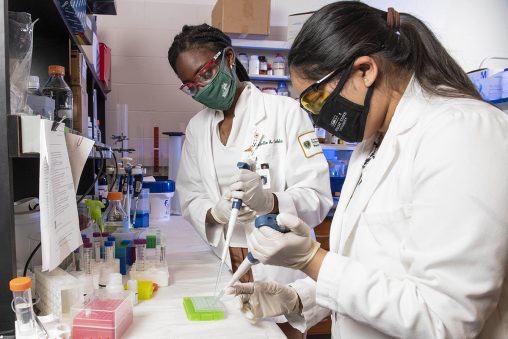
Danielle Corbin, left, a dual degree M.D.-M.S. student, and Lea Christian, graduate pharmacology and toxicology student, are involved in a research project studying the effects of sunlight on the body.
From developing a super sunscreen to monitoring brain injuries to tracking COVID-19 misinformation, Wright State University faculty and students pursued important research endeavors in 2021.
Here are some of the top research stories that appeared in the Wright State Newsroom in 2021:
Jeffrey Travers and Yanfang Chen receive $1.7 million NIH grant to study effects of sunlight
A super sunscreen for people hypersensitive to sunlight could be the end result of research at Wright State thanks to a $1.7 million grant from the National Institutes of Health.
The five-year NIH grant was awarded to Jeffrey Travers, M.D., Ph.D., professor and chair of the Department of Pharmacology and Toxicology, and Yanfang Chen, M.D., Ph.D., professor of pharmacology and toxicology.
“This grant is designed to try to understand how UVB radiation — the burning rays of sunlight — can signal in the body,” said Travers. “And we are particularly interested in photosensitivity — how some people have exaggerated responses to sunlight. One of the areas involves clinically testing a drug to see if it can block these exaggerated effects.”
“We believe we have identified a novel pathway that is disturbed in people with sun sensitivity,” Travers said. “When they are stressed, cells will release little parts of themselves called microvesicle particles from the plasma membrane.” Read more >>
Hongmei Ren receives federal research awards to explore therapies for muscular dystrophy
Hongmei Ren, Ph.D., assistant professor of biochemistry and molecular biology, received a federal research grant and an award totaling $2.4 million that could lead to therapies to combat diseases like muscular dystrophy.
Ren received an R01 grant from the National Institutes of Health National Institute of Arthritis and Musculoskeletal and Skin Diseases and an Idea Development award from the Department of Defense to explore gene therapy in Duchenne muscular dystrophy.
The knowledge gained from Ren’s work may open new avenues of research in several related muscular diseases. And understanding how to improve muscle membrane integrity could lead to therapies that can combat diseases like muscular dystrophy. Read more >>
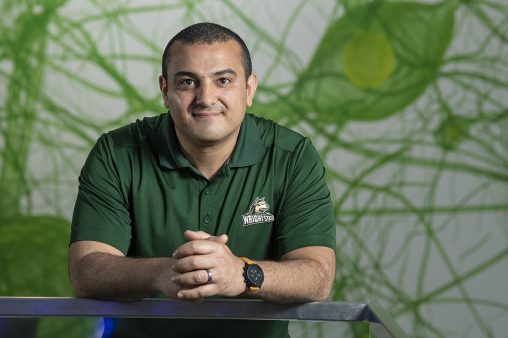
Sherif Elbasiouny, professor of neuroscience, cell biology and physiology and director of neuroengineering education and research, is researching the neural mechanisms underlying weakness in aging.
Sherif Elbasiouny awarded $3 million federal grant to study weakness in aging
Sherif Elbasiouny, Ph.D., professor of neuroscience, cell biology and physiology and director of neuroengineering education and research, is leading a research project examining the neural mechanisms underlying weakness in aging. Elbasiouny and researchers from Ohio State and Ohio University received a $3 million grant from the National Institute on Aging at the National Institutes of Health.
Elbasiouny said the grant shifts the focus of the aging field to the nervous system away from the muscle. Elbasiouny said little is known about the changes in the nervous system during aging and that research by scientists involved in the project suggests that other neurological factors are critical in the development of weakness.
Elbasiouny said the research has the potential to identify early neural biomarkers for weakness and develop new interventions to enhance strength and function in older adults. Read more >>
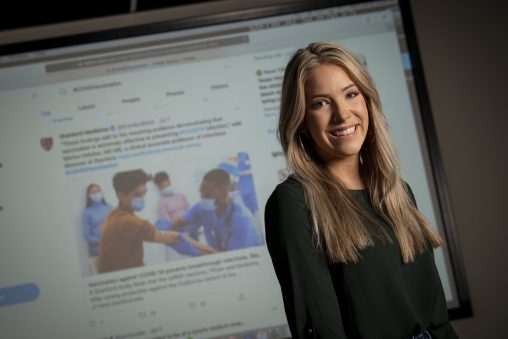
Biological sciences graduate student Emily Burwell researches COVID-19 information and misinformation on Twitter.
Graduate student researches COVID-19 social media information, misinformation
Trying to make an impact in the fields of science education and public health has become a passion for Emily Burwell, a biological sciences graduate student researching COVID-19 truth from fiction.
Burwell researched COVID-19 messaging on Twitter, focusing on information-related tweets and attempting to quantify the proportion of misinformation to validated information in them.
“I wanted to look at a problem that could apply to other diseases or public health in general,” she said. “Misinformation circulates social media and can leave lasting, detrimental impressions on people. This, in turn, creates a huge challenge for public health.” Read more >>

A talk by Paul Lockhart, professor of history, about his book “Firepower: How Weapons Shaped Warfare” attracted C-SPAN’s “Book TV.”
Book talk by historian Paul Lockhart brings C-SPAN to Wright State
A talk by Paul Lockhart, Ph.D., professor of history, about his new book, “Firepower: How Weapons Shaped Warfare,” drew C-SPAN to campus to record the event its “Book TV” program.
“We’re thrilled that C-SPAN and ‘Book TV’ are here to record Paul Lockhart’s talk about his newly released book ‘Firepower,’” said event organizer Crystal Lake, Ph.D., professor of English language and literatures. “Having C-SPAN is such a great honor because ‘Book TV’ has so many viewers. It’s a really great opportunity for exposure for Wright State and for Professor Lockhart’s new book.”
“Firepower: How Weapons Shaped Warfare” is about how the evolution of weapons technology changed the way that armies and navies fought and helped define the modern state and the international order. Read more >>
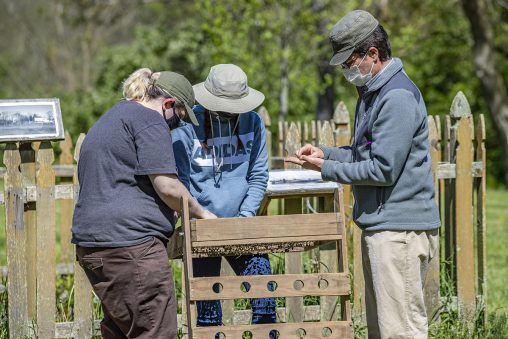
Lance Greene, associate professor of anthropology, right, and anthropology students searched for evidence of a Shawnee fort at George Rogers Clark Park.
Anthropology students dig for evidence of historic Shawnee fort
The 10 students were fanned out on a grassy bluff that overlooks a historic battlefield. They were digging for traces of a Native American fort torched by American forces in 1780.
The excavation unfolded at George Rogers Clark Park near the Mad River just northeast of Wright State. It was all part of the Field School in Archaeology offered in an anthropology course in the College of Liberal Arts.
“This site is probably the location of the fort,” said Lance Greene, Ph.D., associate professor of anthropology. “The Shawnee built this three-sided, palisaded fort to defend against the Americans, and the Americans burned it to the ground. So we’re looking for evidence.” Read more >>
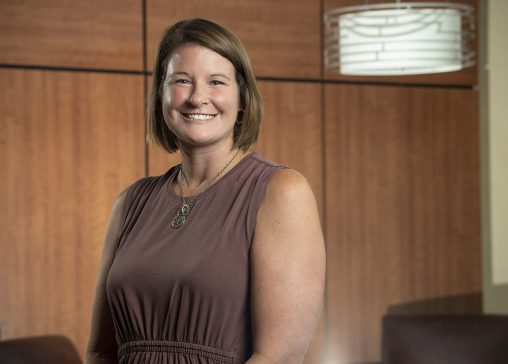
Nicole Kinzeler, associate director of the SARDI Program, received a grant to provide training and collect and evaluate data from providers offering substance abuse treatment and recovery services in Ohio.
Nicole Kinzeler receives $1.45 million grant to analyze data from Ohio opioid and substance abuse treatment program
Nicole Kinzeler, assistant professor in the Department of Population and Public Health Sciences and associate director of the Substance Abuse Resources and Disability Issues (SARDI) Program, received a grant to provide training and collect and evaluate data from providers offering substance abuse treatment and recovery services in Ohio.
SARDI’s role in the project includes data collection training for providers; collecting and analyzing participants’ data; producing reports about the data; and managing the gift card incentives for clients who complete data collection interviews with providers.
SARDI’s data collection highlights the successes of the programs and identified service gaps. The program’s reports have been used by the state to successfully apply for additional federal funding and by providers for other grant applications, accreditation processes, board reports and marketing. Read more >>
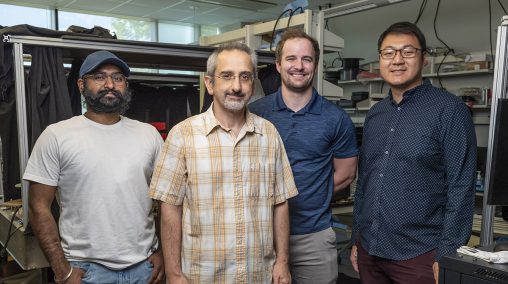
Ulas Sunar, Ohio Research Scholar and Endowed Chair in Medical Imaging, second from left, with engineering graduate students, Dharminder Langri, left, Benjamin Rinehart, second from right, and Chien Poon.
Ulas Sunar wins prestigious NIH Brain Initiative research grant
Ulas Sunar, Ph.D., an Ohio Research Scholar and Endowed Chair in Medical Imaging, has received an $811,410 federal grant to develop a novel neuromonitoring approach for monitoring patients with acute brain injuries in neurointensive care units.
He received a two-year R01 grant from the National Institute of Biomedical Imaging and Bioengineering in the National Institutes of Health, as part of the U.S. Brain Initiative.
The goal of Sunar’s grant is to develop a novel optical technology that provides blood flow measurements with higher sensitivity to brain tissue. The researchers are working to develop a non-invasive method for cerebral blood flow monitoring that could be a safer alternative to traditional methods. Read more >>

Filamentous Cladophora carpet the bottom of coastal Lake Michigan because invasive mussels clarify the water and transport nutrients to the lake bottom. (Photo credit: Harvey Bootsma)
Attached algal blooms are an emerging threat to clear lakes worldwide
Many of the world’s most iconic clear lakes are degrading at an alarming rate — shallow, nearshore lake bottoms are being carpeted by bright green fronds of slimy algae, especially during the summer.
In a scientific article published in BioScience, “Blue waters, green bottoms: benthic filamentous algal blooms are an emerging threat to clear lakes worldwide,” scientists from around the world explored how nutrient pollution, climate change, loss of aquatic animals that eat algae, and invasive species contribute to the increased occurrence of green bottoms.
Lead author Yvonne Vadeboncoeur, Ph.D., a professor of biological sciences, is particularly concerned that widespread use of pesticides, or other stressors, may be killing aquatic insects, allowing the algae to grow unchecked instead of being consumed by grazing insects that then provide critical food for fish.
She also thinks the public could play a role in helping scientists document the occurrence of filamentous algal blooms (FABs).
“Scientists tend to study lakes from boats in the middle of the lake, but the pristine shorelines that are afflicted by these green bottoms are the same places that attract people for swimming, fishing and boating. We see the public playing a crucial future role in documenting the occurrence of this emerging change in lakes,” Vadeboncoeur said. Read more >>
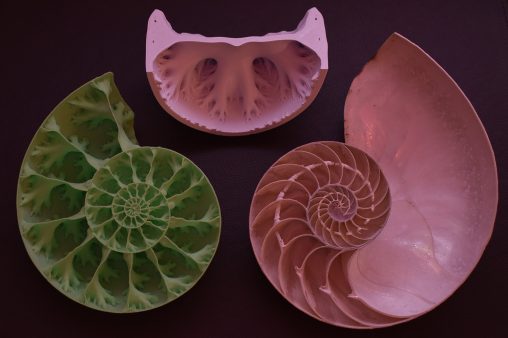
Chuck Ciampaglio, professor of Earth and environmental science, and alumnus David Peterman discovered how an extinct animal moved in water.
New research by Chuck Ciampaglio published by prestigious international journal
New research by Chuck Ciampaglio, Ph.D., professor of Earth and environmental science at the Lake Campus, and alumnus David Peterman into relatives of the squid that went extinct with the dinosaurs was published by Scientific Reports – Nature.
The research sheds new light on ammonites, externally shelled relatives of the squid that went extinct nearly 66 million years ago. Titled “Buoyancy control in ammonoid cephalopods refined by complex internal shell architecture,” the research paper explains how the evolution of the animals’ shells made them more maneuverable in the water.
“We managed to bring these creatures back to life,” said Ciampaglio. “We 3-D printed them with the correct mass, gave them propulsion, put them in tanks, and we could see how they moved.” Read more >>
Awad Halabi wins Fellowship award to conduct research in Jerusalem on Islamic activist
Awad Halabi, Ph.D., associate professor of history and religion, received a Fellowship award to conduct research in Jerusalem focusing on an Islamic activist who reflects historical shifts in Palestinian identity.
The $7,000 US Fellowship award from the U.S.-based Palestine American Research Center will enable Halabi to work in Jerusalem and possibly Amman, Jordan, next spring for up to four months.
The study will examine the life of Arab and political figure Shaykh `Abd al-Qadir al-Muzaffar from 1917 to 1949.
“The research can reveal how this historical figure shaped questions about national identity, colonialism and religious practice in Palestine from the closing days of Ottoman rule to the end of British colonialism,” Halabi said. Read more >>
Biologists Shulin Ju, Quan Zhong receive $450,000 federal research grant to study neurological disease
Shulin Ju, Ph.D., and Quan Zhong, Ph.D., associate professors of biological sciences, received a $450,000 grant from the National Institutes of Health to conduct research related to the neurological disease ALS
“Both undergraduate and graduate students have made huge contributions to research in our labs,” said Ju. “With this funding, we will support many more talented undergraduate and graduate students to gain research experience that otherwise will be cut short.”
The research is aimed at understanding mechanisms of the cellular toxicity of the protein-coding gene FUS, mutations in which cause ALS. Read more >>



 Milling around
Milling around  Wright State recognizes Nursing Professor Kim Ringo for advancing international student success
Wright State recognizes Nursing Professor Kim Ringo for advancing international student success  Wright State honors graduating students for distinguished doctoral dissertations
Wright State honors graduating students for distinguished doctoral dissertations  Top 10 Newsroom videos of 2025
Top 10 Newsroom videos of 2025  Museum-quality replica of historic Hawthorn Hill donated to Wright State
Museum-quality replica of historic Hawthorn Hill donated to Wright State 